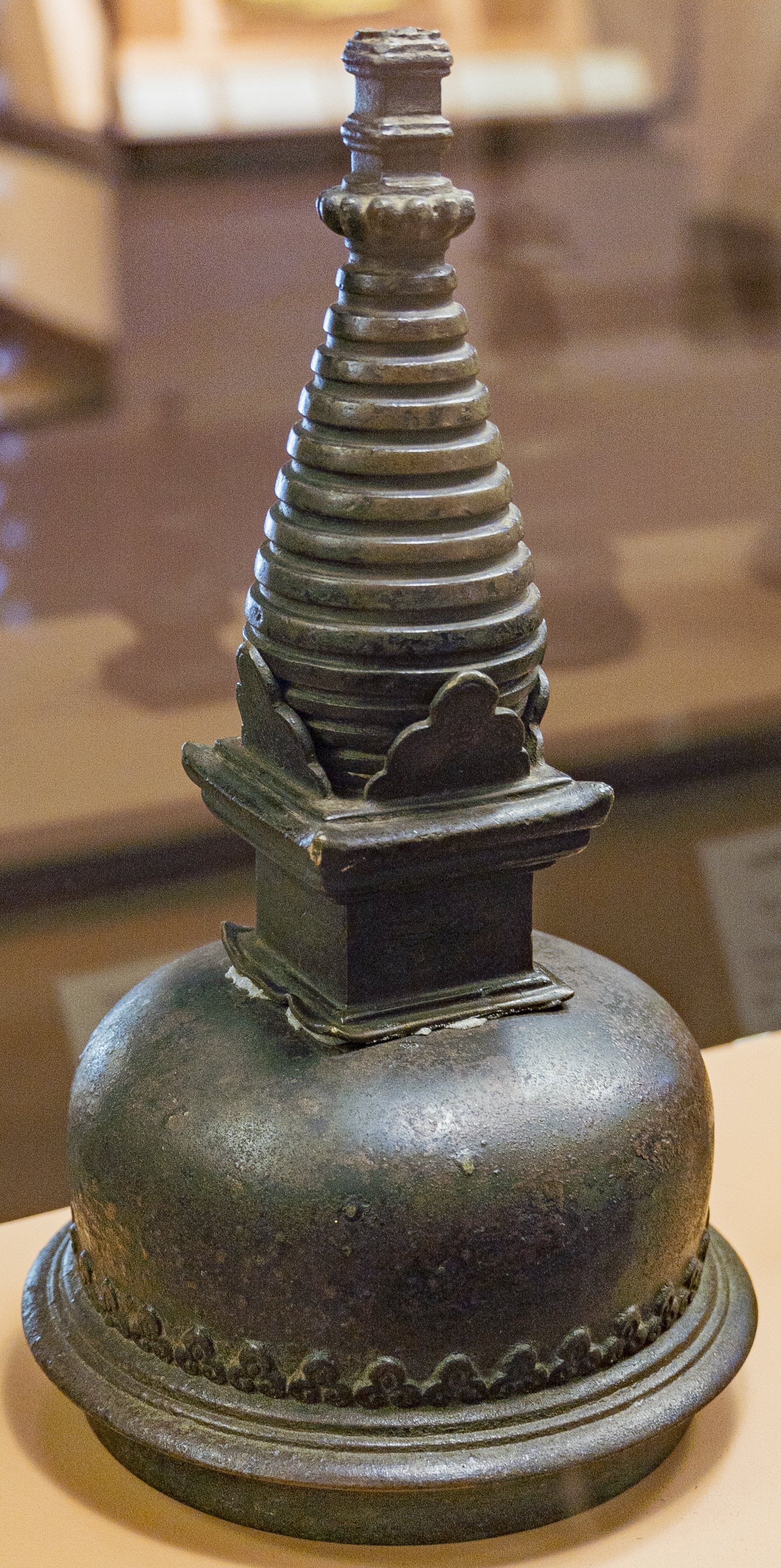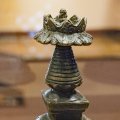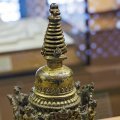Patan Museum (Nepal): photo 135
Photo 135 of 212 in Gallery: Patan Museum (Nepal)

Image title: Chaitya with Missing Drum
Description of the photo
This Bronze sculpture shows an image of a Chaitya with Missing Drum, from the 17th/18th century origination from Nepal.—Materials used: Bronze.
Description: This small chaitya differs little from more imposing ones which served as its model, except for the missing drum (pedestal). The dome has a stepped moulding and an encircling trefoil motif which may refer to the Three Jewels (the Buddha, his teachings, and the monastic community). The cube over the dome is incised with a stylized Buddha face: eyes flanking an urna from which emanate miraculous rays of light represented by the curved line below. Against the thirteen-tiered finial, four shields are arranged, each incised with the motif related to the Transcendent Buddha below. The finial terminates in a lotiform disc (amalaka) above which projects the tip of an imagined central pillar.
Notes: This image is number (6) in the series: The Chaitya: All-Pervasive Monument of Buddhism—An architectural monument unique to Buddhism, the stupa, chaitya, or (in Tibetan) Chörten, is a dominant feature throughout the Buddhist world, past and present. It exists in countless Silk Road ruins and the mounds of southern Nepal, as famous archaeological monuments like India’s Sanchi or Java’s awesome Borobudur, in Burma's or Thailand's actively worshiped myriads, or Nepal's imposing Bodhnath [Boudhanath] and Svayambhu. Chaityas are sometimes minor votive structures, two to four meters high. In Nepal such chaityas crowd the sacred precincts of Svayambhu, embroider the plinths of large stupas like Kathmandu’s Kathesimbhu, embellish monastery and domestic courtyards, sanctify ancient sunken fountains, and dot the waysides. Miniature chaityas a tenth the size of votive chaityas are carried as personal icons (7) or placed in household or monastery shrines (2, 4, 5, 6, 8). The chaitya is also an all-pervasive sacred emblem. It adorns the mystic crown of the Buddhist priest. It serves as a primary attribute or associate of gods and goddesses such as Maitreya (1) and Ushnisha-vijaya (9). It is the subject of countless Nepalese paintings, and appears carved as tiny motifs on the votive chaityas themselves. It is annually created in clay by the disposable thousands, and carved into the lintels of monastery portals to bless all who enter.
Gallery information:
The Patan Museum is located on the Durbar square of Patan (Lalitpur/Lalitapura, Kathmandu, Nepal) which is associated Keshav Narayan Chowk (Keshavnarayan)—a form of Lord Vishnu. Being listed as a World Heritage Site, the whole of Durbar square is filled with exquisite temples, sculptures and other ancient structures, of which the ancient history history can be traced to the Malla Kings of Lalitpur. It is an important site for both Buddhism and Hinduism.
Photo details:
Date: 2019-12-02
Camera: SONY ILCE-6400
Exposure: 1/20
Aperture: f/4.5
ISO: 100
Focal length: 29mm
High resolution:
Download file
Size: 3.99 MB
Resolution: 1842 x 3696
© Photograph by Gabe Hiemstra.
License: CC BY-NC-ND 4.0

